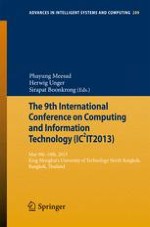2013 | Book
The 9th International Conference on Computing and InformationTechnology (IC2IT2013)
9th-10th May 2013 King Mongkut's University of Technology North Bangkok
Editors: Phayung Meesad, Herwig Unger, Sirapat Boonkrong
Publisher: Springer Berlin Heidelberg
Book Series : Advances in Intelligent Systems and Computing
